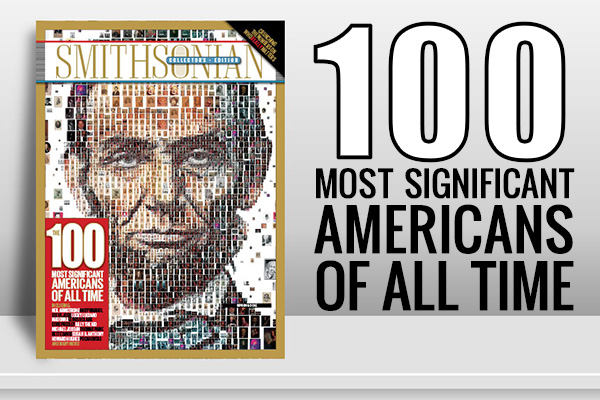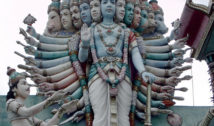
11 Religious Figures Named Amongst The 100 Most Significant Americans Of All Time By Smithsonian Magazine
- By WRN Editorial Staff --
- 08 Oct 2014 --
Meet the 100 most significant Americans of all time http://t.co/CByk5EGFQX pic.twitter.com/JVu4yehnh9
— Smithsonian Magazine (@SmithsonianMag) November 17, 2014
Smithsonian Magazine included 11 American religious figures in their list of “The 100 Most Significant Americans Of All Time,’ and they are…
Joseph Smith Jr., the founder of Mormonism, William Penn, an English real estate entrepreneur, philosopher, early Quaker and founder of the Province of Pennsylvania, Brigham Young, 2nd President of the LDS Church, Roger Williams, an English Protestant theologian who was an early proponent of religious freedom and the separation of church and state, Anne Hutchinson, a Puritan woman who spread her own interpretations of the Bible, leading to the Antinomian Controversy in the Massachusetts Bay Colony, Jonathan Edwards, a Christian preacher and theologian widely acknowledged to be America’s most important and original philosophical theologian, L. Ron Hubbard, founder of the Scientology religion, Ellen G. White, a prolific author and American Christian pioneer who formed what is now the Seventh-Day Adventist Church, Cotton Mather, a socially and politically influential New England Puritan minister, prolific author and pamphleteer, Mary Baker Eddy, the founder of Christian Science, and Billy Graham, an American evangelical Christian evangelist, ordained as a Southern Baptist minister.
They are all part of the newly compiled list from Smithsonian Magazine that includes a storied list of Americans stretching all the way from Benedict Arnold to Madonna.
But just HOW did Smithsonian Magazine go about the incredibly difficult task of ranking the 100 most Significant Americans of all time?
They started with a Google engineer, of course, then mixed in social analytics plus a dash of learned opinion, and voila…
 Steven Skiena is the Distinguished Teaching Professor of Computer Science at Stony Brook University and a co-founder of the social-analytics company General Sentiment. Charles B. Ward is an engineer at Google, specializing in ranking methodologies. Their approach to selecting the significant people in the Smithsonian Magazines list involves high-level math. They subject the historical zeitgeist to the brute rigors of quantitative analysis in a recent book, Who’s Bigger? Where Historical Figures Really Rank.
Steven Skiena is the Distinguished Teaching Professor of Computer Science at Stony Brook University and a co-founder of the social-analytics company General Sentiment. Charles B. Ward is an engineer at Google, specializing in ranking methodologies. Their approach to selecting the significant people in the Smithsonian Magazines list involves high-level math. They subject the historical zeitgeist to the brute rigors of quantitative analysis in a recent book, Who’s Bigger? Where Historical Figures Really Rank.
Smithsonian Magazine describes the complete methodology that went into their selection process, here…
Simply put, Skiena and Ward have developed an algorithmic method of ranking historical figures, just as Google ranks web pages. But while Google ranks web pages according to relevance to your search terms, Skiena and Ward rank people according to their historical significance, which they define as “the result of social and cultural forces acting on the mass of an individual’s achievement.” Their rankings account not only for what individuals have done, but also for how well others remember and value them for it.
Their method requires a massive amount of big data on historical reputation. This they found in the English-language Wikipedia, which has more than 840,000 pages devoted to individuals from all times and places, plus data extracted from the 15 million books Google has scanned. They analyzed this data to produce a single score for each person, using a formula that incorporates the number of links to each page, the number of page visits, the length of each entry and the frequency of edits to each page. Their algorithms differentiate between two kinds of historical reputation, what they call “gravitas” and “celebrity.” Finally, their method requires a means of correcting for the “decay” in historical reputation that comes with the passage of time; they developed an algorithm for that, too. By their reckoning, Jesus, Napoleon, Muhammad, William Shakespeare and Abraham Lincoln rank as the top five figures in world history. Their book ranks more than 1,000 individuals from all around the world, providing a new way to look at history.
Skiena and Ward would be the first to acknowledge that their method has limitations. Their concept of significance has less to do with achievement than with an individual’s strength as an Internet meme—how vividly he or she remains in our collective memory. The English-language Wikipedia favors Americans over foreigners, men over women, white people over others and English speakers over everyone else. In their rankings of Americans only, past presidents occupy 39 of the first 100 spots, suggesting an ex-officio bias.
That’s where we come in. Smithsonian magazine has been covering American history in depth from its inaugural issue, published in 1970. Among the Smithsonian Institution museums we work closely with is the National Museum of American History. By synthesizing our expertise with the systematic rigor of Skiena and Ward’s rankings, we sought to combine the best of quantitative measures and qualitative judgment.
First, we asked Skiena and Ward to separate figures significant to American history from the world population. Then, rather than simply taking their top 100, we developed categories that we believe are significant, and populated our categories with people in Skiena and Ward’s order (even if they ranked below 100). This system helped mitigate the biases of Wikipedia.
We have highlighted what we decided was the most interesting choice within each category with a slightly fuller biographical sketch. And finally, we made an Editors’ Choice in each category, an 11th American whose significance we’re willing to argue for.
Argument, of course, has been integral to American historiography from the beginning. When Andrew Gelman, a professor of statistics and political science at Columbia University, wrote that Who’s Bigger? “is a guaranteed argument-starter,” he meant it as a compliment. We hope our list will spark a few passionate discussions as well.
Below, the Smithsonian Magazine’s entire list. You can read more about what made each person siginficant, by picking up a copy of the special issue at a newsstand near you.
Trailblazers
Christopher Columbus
Henry Hudson
Amerigo Vespucci
John Smith
Giovanni da Verrazzano
John Muir
Meriwether Lewis and William Clark
Sacagawea
Kit Carson
Neil Armstrong
John Wesley Powell
Rebels & resisters
Martin Luther King Jr.
Robert E. Lee
Thomas Paine
John Brown
Frederick Douglass
Susan B. Anthony
W.E.B. Du Bois
Tecumseh
Sitting Bull
Elizabeth Cady Stanton
Malcolm X
Presidents
Abraham Lincoln
George Washington
Thomas Jefferson
Theodore Roosevelt
Ulysses S. Grant
Ronald W. Reagan
George W. Bush
Franklin Delano Roosevelt
Woodrow Wilson
James Madison
Andrew Jackson
First Women
Pocahontas
Eleanor Roosevelt
Hillary Clinton
Sarah Palin
Martha Washington
Hellen Keller
Sojourner Truth
Jane Addams
Edith Wharton
Bette Davis
Oprah Winfrey
Outlaws
Benedict Arnold
Jesse James
John Wilkes Booth
Al Capone
Billy the Kid
William M. “Boss” Tweed
Charles Manson
Wild Bill Hickok
Lee Harvey Oswald
John Dillinger
Lucky Luciano
Artists
Frank Lloyd Wright
Andy Warhol
Frederick Law Olmsted
James Abbott MacNeill Whistler
Jackson Pollock
John James Audubon
Georgia O’Keeffe
Thomas Eakins
Thomas Nast
Alfred Stieglitz
Ansel Adams
Religious figures
Joseph Smith Jr.
William Penn
Brigham Young
Roger Williams
Anne Hutchinson
Jonathan Edwards
L. Ron Hubbard
Ellen G. White
Cotton Mather
Mary Baker Eddy
Billy Graham
Pop icons
Mark Twain
Elvis Presley
Madonna
Bob Dylan
Michael Jackson
Charlie Chaplin
Jimi Hendrix
Marilyn Monroe
Frank Sinatra
Louis Armstrong
Mary Pickford
Empire-builders
Andrew Carnegie
Henry Ford
John D. Rockefeller
J.P. Morgan
Walt Disney
Thomas Alva Edison
William Randolph Hearst
Howard Hughes
Bill Gates
Cornelius Vanderbilt
Steve Jobs
Athletes
Babe Ruth
Muhammad Ali
Jackie Robinson
James Naismith
Arnold Schwarzenegger
Ty Cobb
Michael Jordan
Hulk Hogan
Jim Thorpe
Secretariat
Billie Jean King



















